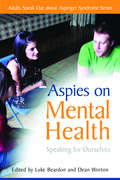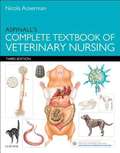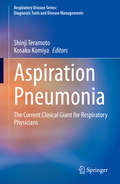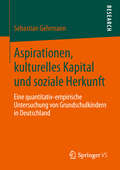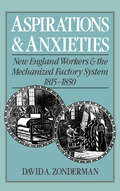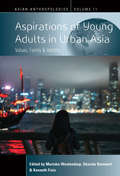- Table View
- List View
Aspies on Mental Health: Speaking for Ourselves (PDF)
by Alexandra Brown Anne Henderson Anthony Sclafani Chris Mitchell Chris Smedley Christopher Wilson Dean Worton Debbie Allan E Veronica Bliss Janet Christmas Luke Beardon Lynette Marshall Melanie Smith Natasha Goldthorpe Neil Shepherd Stephen Jarvis Stephen William Cornwell Wendy LimPeople with Asperger Syndrome (AS) can be particularly at risk of developing mental health difficulties such as anxiety and depression. Here, adults with Asperger Syndrome speak out about their own experiences of mental health issues, offering sound advice for other Aspies and providing valuable insights for family, friends and also for mental health professionals. Touching on everything from difficulties at work and college to coping with low self-confidence, self-harm, alcohol, misdiagnosis, sectioning, counselling, medication and battles with mental health services, the book provides a window into how people with AS experience mental health issues, and what can be done to help. The individual accounts describe innovative coping strategies and methods for maintaining emotional and psychological wellbeing as well as practical advice on things like how to stay positive and deal with day-to-day stress and meltdowns. This is essential reading for adults with Asperger Syndrome, and their families and friends, and will be a useful resource for psychologists, psychiatrists, mental health service providers and other professionals who support adults with Asperger Syndrome.
Aspinall's Complete Textbook of Veterinary Nursing E-Book
by Victoria Aspinall Nicola AckermanThe third edition of Aspinall’s Complete Textbook of Veterinary Nursing is the ideal text for both student and qualified veterinary nurses as it covers the entire veterinary nursing syllabus. Now written in the main by veterinary nurses this book comprehensively covers all aspects of the veterinary nursing role from client communication to nutritional support. All chapters have been revised in line with changes in legislation and regulation but also theoretical and practical aspects. Greater emphasis on the veterinary practice structure including the role of corporate businesses and use of social media bring this edition fully up to date. The new edition welcomes Nicola Ackerman as principal editor. Nicola is past officer of the BVNA and past executive editor of the Veterinary Nursing Journal. Nicola is a winner of several awards including the Blue Cross/BVNA Veterinary Nurse of the Year and the Barbara Cooper / CAW Professional Development Award for outstanding service to the veterinary nursing profession. Nicola was the first Veterinary Nurse in the UK to become a veterinary nurse specialist in nutrition. Evolve Resources containing Self-assessment questions for every chapter to test learning Image Bank of over 700 figures Additional chapters Comprehensive content ideal for both student and qualified veterinary nurses Over 700 full colour illustrations for enhanced understanding Written by veterinary nurses for veterinary nurses Recommended reading given for each chapter to aid further research New chapters on Emergency Critical care, Fluid therapy, Practice and Staff management and Consulting skills. Anaesthesia and Analgesia chapter fully revised and updated. New chapter on Equine Behaviour and Handling, including recognition of pain in equines.
Aspinall's Complete Textbook Of Veterinary Nursing (PDF)
by Nicola Ackerman Victoria AspinallThe third edition of Aspinall's Complete Textbook of Veterinary Nursing is the ideal text for both student and qualified veterinary nurses as it covers the entire veterinary nursing syllabus. Now written in the main by veterinary nurses this book comprehensively covers all aspects of the veterinary nursing role from client communication to nutritional support. All chapters have been revised in line with changes in legislation and regulation, but also theoretical and practical aspects. Greater emphasis on the veterinary practice structure including the role of corporate businesses and use of social media bring this edition fully up to date. The new edition welcomes Nicola Ackerman as principal editor. Nicola is past officer of the BVNA and editor of the Veterinary Nursing Journal, and is currently the chair of The Pet Obesity Taskforce. Nicola is a winner of several awards including the Blue Cross/BVNA Veterinary Nurse of the Year 2010. Nicola was the first Veterinary Nurse in the UK to become a veterinary nurse specialist in nutrition. Comprehensive content ideal for both student and qualified veterinary nurses Over 700 full colour illustrations for enhanced understanding Written by veterinary nurses for veterinary nurses Recommended reading given for each chapter to aid further research Evolve Resources containing Self-assessment questions for every chapter to test learning Image Bank of over 700 figures Additional chapters New chapters on Emergency Critical care, Fluid therapy, Practice and Staff management and Consulting skills. Anaesthesia and Analgesia chapter fully revised and updated. New chapter on Equine Behaviour and Handling, including recognition of pain in equines.
Aspiration: The Agency of Becoming
by Agnes CallardBecoming someone is a learning process; and what we learn is the new values around which, if we succeed, our lives will come to turn. Agents transform themselves in the process of, for example, becoming parents, embarking on careers, or acquiring a passion for music or politics. How can such activity be rational, if the reason for engaging in the relevant pursuit is only available to the person one will become? How is it psychologically possible to feel the attraction of a form of concern that is not yet one's own? How can the work done to arrive at the finish line be ascribed to one who doesn't (really) know what one is doing, or why one is doing it? In Aspiration, Agnes Callard asserts that these questions belong to the theory of aspiration. Aspirants are motivated by proleptic reasons, acknowledged defective versions of the reasons they expect to eventually grasp. The psychology of such a transformation is marked by intrinsic conflict between their old point of view on value and the one they are trying to acquire. They cannot adjudicate this conflict by deliberating or choosing or deciding-rather, they resolve it by working to see the world in a new way. This work has a teleological structure: by modeling oneself on the person he or she is trying to be, the aspirant brings that person into being. Because it is open to us to engage in an activity of self-creation, we are responsible for having become the kinds of people we are.
Aspiration Based Decision Support Systems: Theory, Software and Applications (Lecture Notes in Economics and Mathematical Systems #331)
by Andrzej Lewandowski Andrzej P. WierzbickiIt is not easy to summarize -even in a volume -the results of a scientific study con ducted by circa 30 researchers, in four different research institutions, though cooperating between them and jointly with the International Institute for Applied Systems Analysis, but working part-time, sponsored not only by IIASA's national currency funds, but also by several other research grants in Poland. The aims of this cooperative study were de fined broadly by its title Theory, Software and Testing Examples for Decision Support Systems. The focusing theme was the methodology of decision analysis and support related to the principle of reference point optimization (developed by the editors of this volume and called also variously: aspiration-led decision support, quasi-satisfying framework of rationality, DIDAS methodology etc. ). This focusing theme motivated extensive theoretical research - from basic methodological issues of decision analysis, through various results in mathematical programming (in the fields of large scale and stochastic optimization, nondifferentiable optimization, cooperative game theory) mo tivated and needed because of this theme, through methodological issues related to software development to issues resulting from testing and applications. We could not include in this volume all papers -theoretical, methodological, appiied, software manu als and documentation -written during this cooperative study.
ASPIRATION C: The Agency of Becoming
by Agnes CallardBecoming someone is a learning process; and what we learn is the new values around which, if we succeed, our lives will come to turn. Agents transform themselves in the process of, for example, becoming parents, embarking on careers, or acquiring a passion for music or politics. How can such activity be rational, if the reason for engaging in the relevant pursuit is only available to the person one will become? How is it psychologically possible to feel the attraction of a form of concern that is not yet one's own? How can the work done to arrive at the finish line be ascribed to one who doesn't (really) know what one is doing, or why one is doing it? In Aspiration, Agnes Callard asserts that these questions belong to the theory of aspiration. Aspirants are motivated by proleptic reasons, acknowledged defective versions of the reasons they expect to eventually grasp. The psychology of such a transformation is marked by intrinsic conflict between their old point of view on value and the one they are trying to acquire. They cannot adjudicate this conflict by deliberating or choosing or deciding-rather, they resolve it by working to see the world in a new way. This work has a teleological structure: by modeling oneself on the person he or she is trying to be, the aspirant brings that person into being. Because it is open to us to engage in an activity of self-creation, we are responsible for having become the kinds of people we are.
Aspiration Cytology in the Staging of Urological Cancer: Clinical, Pathological and Radiological Bases (pdf)
by Lucio Luciani Francesco PiscioliAspiration Pneumonia: The Current Clinical Giant for Respiratory Physicians (Respiratory Disease Series: Diagnostic Tools and Disease Managements)
by Shinji Teramoto Kosaku KomiyaThis book offers an essential overview of aspiration pneumonia, and focuses on four major aspects: epidemiology, pathophysiology, new preventive strategies, and trending topics. Each part presents detailed findings and insights into critical issues for the treatment of the disease including its diagnosis, assessment, selecting antibiotics, similarities and differences between aspiration risk and aspiration pneumonia risk, different therapeutic approaches and so on. The book also discusses emerging topics concerning the definition of NHCAP and sleep apnea. Special attention is given to therapeutic and preventive approaches for the elderly, highlighting recent advances and the evidence on their positive outcomes. Since the patients with this disorder are often in a post-stroke state and elderly, the book is highly relevant for neurologists and geriatric physicians. Further, many surgeons also face this type of pneumonia in association with postoperative complications and cancer therapy related complications. Lastly, the definition of aspiration pneumonia and its therapeutic strategy have yet to be established in many countries, and the data presented here should serve as a guideline for its future diagnosis and treatment. As such, the book offers a valuable resource for primary physicians, pulmonologists, gerontologists, respiratory nurses, physical therapists, dentists and otolaryngologists alike.
Aspiration, Representation and Memory: The Guise in Europe, 1506–1688
by Penny Richards Jessica MunnsExploiting the turbulence and strife of sixteenth-century France, the House of Guise arose from a provincial power base to establish themselves as dominant political players in France and indeed Europe, marrying within royal and princely circles and occupying the most important ecclesiastical and military positions. Propelled by ambitions derived from their position as cadets of a minor sovereign house, they represent a cadre of early modern elites who are difficult to categorise neatly: neither fully sovereign princes nor fully subject nobility. They might have spent most of their time in one state, France, but their interests were always ’trans-national’; contested spaces far from the major centres of monarchical power - from the Ardennes to the Italian peninsula - were frequent theatres of activity for semi-sovereign border families such as the Lorraine-Guise. This nexus of activity, and the interplay between princely status and representation, is the subject of this book. The essays in this collection approach Guise aims, ambitions and self-fashioning using this ’trans-national’ dimension as context: their desire for increased royal (rather than merely princely) power and prestige, and the use of representation (visual and literary) in order to achieve it. Guise claims to thrones and territories from Jerusalem to Naples are explored, alongside the Guise ’dream of Italy’, with in-depth studies of Henry of Lorraine, fifth Duke of Guise, and his attempts in the mid-seventeenth century to gain a throne in Naples. The combination of the violence and drama of their lives at the centres of European power and their adroit use of publicity ensured that versions of their strongly delineated images were appropriated by chroniclers, playwrights and artists, in which they sometimes featured as they would have wished, as heroes and heroines, frequently as villains, and ultimately as characters in the narratives of national heritage.
Aspiration, Representation and Memory: The Guise in Europe, 1506–1688
by Penny Richards Jessica MunnsExploiting the turbulence and strife of sixteenth-century France, the House of Guise arose from a provincial power base to establish themselves as dominant political players in France and indeed Europe, marrying within royal and princely circles and occupying the most important ecclesiastical and military positions. Propelled by ambitions derived from their position as cadets of a minor sovereign house, they represent a cadre of early modern elites who are difficult to categorise neatly: neither fully sovereign princes nor fully subject nobility. They might have spent most of their time in one state, France, but their interests were always ’trans-national’; contested spaces far from the major centres of monarchical power - from the Ardennes to the Italian peninsula - were frequent theatres of activity for semi-sovereign border families such as the Lorraine-Guise. This nexus of activity, and the interplay between princely status and representation, is the subject of this book. The essays in this collection approach Guise aims, ambitions and self-fashioning using this ’trans-national’ dimension as context: their desire for increased royal (rather than merely princely) power and prestige, and the use of representation (visual and literary) in order to achieve it. Guise claims to thrones and territories from Jerusalem to Naples are explored, alongside the Guise ’dream of Italy’, with in-depth studies of Henry of Lorraine, fifth Duke of Guise, and his attempts in the mid-seventeenth century to gain a throne in Naples. The combination of the violence and drama of their lives at the centres of European power and their adroit use of publicity ensured that versions of their strongly delineated images were appropriated by chroniclers, playwrights and artists, in which they sometimes featured as they would have wished, as heroes and heroines, frequently as villains, and ultimately as characters in the narratives of national heritage.
Aspirational Revolution: The Purpose-Driven Economy
by Michael TaillardThis book illustrates how global economic progress has reached its upper limit under the current economic paradigm, and how the next major revolution in global progress will rely on our ability to tap into the collective knowledge of the “everyday genius” to drive innovation, free market competition, artistic influence, and other advances that will allow humanity to overcome its greatest challenges. This volume proposes a grant-based program that will allow innovators to pursue their passions and benefit society as a whole. Such a program will reflect the end of the industrial age, when technology is satisfying many basic needs and creating space for individuals to pursue meaningful, fulfilling careers with the potential to improve our quality of life. Our current economic state mirrors the beginnings of the Agricultural Revolution and Industrial Revolution, and Aspirational Revolution shows how the immediate future will redefine what it means to be human by revolutionizing the manner in which we acquire and utilize the resources necessary for our continued survival. This book is the catalyst by which this transition will occur, providing the models upon which new paradigms will be built – a brand new conception of fundamental economic theory.
Aspirationen, kulturelles Kapital und soziale Herkunft: Eine quantitativ-empirische Untersuchung von Grundschulkindern in Deutschland
by Sebastian GehrmannSebastian Gehrmann untersucht in einer quantitativ-empirischen Studie mit Daten der World Vision Kinderstudie 2013 den Zusammenhang zwischen den Bildungsaspirationen von Grundschulkindern, ihren Freizeitaktivitäten und ihrer sozialen Herkunft. Diese Studie zeichnet sich dadurch aus, dass es hauptsächlich die Kinder selbst sind, die Auskünfte über sich und ihre Lebenswelt geben. Es gelingt dem Autor mithilfe einer differenzierten Erhebung der Konstrukte zu belegen, dass die Wahrscheinlichkeit, dass Kinder auf das Gymnasium wechseln möchten, von verschiedenen Indikatoren der sozialen Herkunft und des kulturellen Kapitals der Kinder beeinflusst wird.
Aspirations, Access and Attainment: International perspectives on widening participation and an agenda for change
by Neil Murray Christopher M. KlingerIt is perhaps ironic that as the global financial crisis has, in some cases, led governments and institutions to pull back from and/or set more modest goals and associated funding around widening participation, there is an ever-growing sense that the ideals buttressing the widening participation movement are becoming more universally acknowledged by educators across the globe. That acknowledgement has translated into action on the ground via such means as policy formulation, strategic planning and target setting – each of which often reflects local contexts and manifests a regional ‘flavour’. There is also, however, an increasing realisation that there are commonalities in the challenges involved with national or regional initiatives to increase the participation of non-traditional groups in higher education and that the drivers of such initiatives – and ultimately the cohorts they target – stand to benefit considerably from an open exchange of ideas and sharing of experience. This book brings together current regional perspectives on widening participation as presented by prominent academics, researchers, policy-makers, and students from across the globe. It will create for policy-makers, institutions, and individuals interested in enabling access, a useful and informative resource that will introduce, formulate, shape and reinforce the ideas and aims of the World Congresses on widening access. As the contributors maintain, in an increasingly globalised market economy and in the face of recent seismic economic, political and social change around the world, it is imperative to both secure existing talent within our populations and uncover and nurture new sources of talent. The series of essays featured in this book will explore, anticipate, and highlight themes underpinning a global movement towards a step-change in thinking, strategies, and policies – one that places youth and students from around the world at its heart.
Aspirations, Access and Attainment: International perspectives on widening participation and an agenda for change
by Neil Murray Christopher M. KlingerIt is perhaps ironic that as the global financial crisis has, in some cases, led governments and institutions to pull back from and/or set more modest goals and associated funding around widening participation, there is an ever-growing sense that the ideals buttressing the widening participation movement are becoming more universally acknowledged by educators across the globe. That acknowledgement has translated into action on the ground via such means as policy formulation, strategic planning and target setting – each of which often reflects local contexts and manifests a regional ‘flavour’. There is also, however, an increasing realisation that there are commonalities in the challenges involved with national or regional initiatives to increase the participation of non-traditional groups in higher education and that the drivers of such initiatives – and ultimately the cohorts they target – stand to benefit considerably from an open exchange of ideas and sharing of experience. This book brings together current regional perspectives on widening participation as presented by prominent academics, researchers, policy-makers, and students from across the globe. It will create for policy-makers, institutions, and individuals interested in enabling access, a useful and informative resource that will introduce, formulate, shape and reinforce the ideas and aims of the World Congresses on widening access. As the contributors maintain, in an increasingly globalised market economy and in the face of recent seismic economic, political and social change around the world, it is imperative to both secure existing talent within our populations and uncover and nurture new sources of talent. The series of essays featured in this book will explore, anticipate, and highlight themes underpinning a global movement towards a step-change in thinking, strategies, and policies – one that places youth and students from around the world at its heart.
Aspirations And Anxieties: New England Workers And The Mechanized Factory System, 1815-1850
by David A. ZondermanAspirations and Anxietiesis a working class intellectual history of early factory operatives in antebellum New England. The book focuses on the operatives' perceptions of technological and socio-economic changes in the mechanized workplace. The study uncovers a complex debate over many facets of the factory system--the machines and factory buildings, wages and hours, relations between managers and workers, and the content and character of protest. Finally, the book argues that the roots of this debate lie in the struggle to define the meaning of work itself in a period of profound social change.
Aspirations and Anxieties: New England Workers and the Mechanized Factory System, 1815-1850
by David A. ZondermanAspirations and Anxieties is a working class intellectual history of early factory operatives in antebellum New England. The book focuses on the operatives' perceptions of technological and socio-economic changes in the mechanized workplace. The study uncovers a complex debate over many facets of the factory system--the machines and factory buildings, wages and hours, relations between managers and workers, and the content and character of protest. Finally, the book argues that the roots of this debate lie in the struggle to define the meaning of work itself in a period of profound social change.
Aspirations, Education and Social Justice: Applying Sen and Bourdieu
by Caroline Sarojini HartCaroline Hart presents a radical new paradigm for thinking about the role of education in the development of human flourishing. The book applies Amartya Sen's capability approach to understanding the nature of aspirations in the policy context of strategies to widen participation in higher education. Sen's work is synthesised with key concepts from Pierre Bourdieu to develop a framework for understanding the processes through which young people are enabled and disabled in relation to developing and achieving their aspirations.Drawing on an empirical study involving 600 young people aged 17-19 in their final years of education, this text explores the hopes and dreams of these young people for the future. The young people's voices challenge dominant discourses of aspiration, well-being and advantage, and invite readers to rethink their own positions on these issues.
Aspirations, Education and Social Justice: Applying Sen and Bourdieu
by Caroline Sarojini HartCaroline Hart presents a radical new paradigm for thinking about the role of education in the development of human flourishing. The book applies Amartya Sen's capability approach to understanding the nature of aspirations in the policy context of strategies to widen participation in higher education. Sen's work is synthesised with key concepts from Pierre Bourdieu to develop a framework for understanding the processes through which young people are enabled and disabled in relation to developing and achieving their aspirations.Drawing on an empirical study involving 600 young people aged 17-19 in their final years of education, this text explores the hopes and dreams of these young people for the future. The young people's voices challenge dominant discourses of aspiration, well-being and advantage, and invite readers to rethink their own positions on these issues.
Aspirations of Young Adults in Urban Asia: Values, Family, and Identity (Asian Anthropologies #11)
by Mariske Westendorp, Désirée Remmert and Kenneth FinisComparing first-person ethnographic accounts of young people living, working, and creating relationships in cities across Asia, this volume explores their contemporary lives, pressures, ideals, and aspirations. Delving into topical issues such as education, social inequality, family pressures, changing values, precarious employment, and political discontent, the book explores how young people are pushing boundaries and imagining their future. In this way, they explore and create the identities of their local and global surroundings.
Aspirations of Young Adults in Urban Asia: Values, Family, and Identity (Asian Anthropologies #11)
by Mariske Westendorp, Désirée Remmert and Kenneth FinisComparing first-person ethnographic accounts of young people living, working, and creating relationships in cities across Asia, this volume explores their contemporary lives, pressures, ideals, and aspirations. Delving into topical issues such as education, social inequality, family pressures, changing values, precarious employment, and political discontent, the book explores how young people are pushing boundaries and imagining their future. In this way, they explore and create the identities of their local and global surroundings.
Aspirations of Young Adults in Urban Asia: Values, Family, and Identity (Asian Anthropologies #11)
by Mariske Westendorp Désirée Remmert Kenneth FinisComparing first-person ethnographic accounts of young people living, working, and creating relationships in cities across Asia, this volume explores their contemporary lives, pressures, ideals, and aspirations. Delving into topical issues such as education, social inequality, family pressures, changing values, precarious employment, and political discontent, the book explores how young people are pushing boundaries and imagining their future. In this way, they explore and create the identities of their local and global surroundings.
ASPIRE to Wellbeing and Learning for All in Early Years and Primary: The Principles Underpinning Positive Education
by Sue RoffeyThis truly accessible resource shows primary school practitioners how to help every student feel valued and included in school so that they develop confidence, resilience, love of learning, a positive sense of self and healthy relationships.Sue Roffey presents a visionary and unique approach to education underpinned by clear principles that can be practically applied in all settings. It is aligned with healthy child development, and addresses what all children need if they are to learn and thrive, including those who experience difficulties and disadvantages. She envisages an education system fit for purpose where all pupils can thrive and make progress in learning, where wellbeing for everyone is at the heart of every school. She uses ASPIRE as an acronym for Agency, Safety, Positivity, Inclusion, Respect and Equity. These principles, when threaded through everything that happens in a school, can genuinely enhance both wellbeing and learning. This resource features a chapter for each principle which explores what this means, why it matters and how it can be applied in early years, primary classrooms and across primary schools. Although visionary, the book is based on both substantial evidence and good practice, with each chapter supported by case studies from across the world.The book demonstrates the positive difference each principle makes to children in primary school settings as well as teachers, parents and the overall community. It is a must-read for primary school teachers, tutors, school leaders, psychologists, parents and anyone who wants an education system that is inclusive, holistic and effective for all students.
ASPIRE to Wellbeing and Learning for All in Early Years and Primary: The Principles Underpinning Positive Education
by Sue RoffeyThis truly accessible resource shows primary school practitioners how to help every student feel valued and included in school so that they develop confidence, resilience, love of learning, a positive sense of self and healthy relationships.Sue Roffey presents a visionary and unique approach to education underpinned by clear principles that can be practically applied in all settings. It is aligned with healthy child development, and addresses what all children need if they are to learn and thrive, including those who experience difficulties and disadvantages. She envisages an education system fit for purpose where all pupils can thrive and make progress in learning, where wellbeing for everyone is at the heart of every school. She uses ASPIRE as an acronym for Agency, Safety, Positivity, Inclusion, Respect and Equity. These principles, when threaded through everything that happens in a school, can genuinely enhance both wellbeing and learning. This resource features a chapter for each principle which explores what this means, why it matters and how it can be applied in early years, primary classrooms and across primary schools. Although visionary, the book is based on both substantial evidence and good practice, with each chapter supported by case studies from across the world.The book demonstrates the positive difference each principle makes to children in primary school settings as well as teachers, parents and the overall community. It is a must-read for primary school teachers, tutors, school leaders, psychologists, parents and anyone who wants an education system that is inclusive, holistic and effective for all students.
Aspirin: The Extraordinary Story of a Wonder Drug
by Diarmuid JeffreysThroughout the world we pop more than 200 billion of these little white pills every year. Aspirin is effective not only against everyday ailments, such as headaches and fever, but also as a preventative treatment for heart attacks, strokes, and even some types of cancers. Add to this its beneficiary role in a host of other conditions from Alzheimer's to gum disease, and you have a medicine of unparalleled importance to humanity, not to mention big business. Yet until 1971 we did not even know how Aspirin worked. In this fascinating and informative book Diarmuid Jeffreys follows the surprising and dramatic story of the drug from its origins in ancient Egypt, through its industrial development at the end of the nineteenth century and its key role in the great flu pandemic of 1918 to its subsequent exploitation by the pharmaceutical conglomerates.
Aspirin: The Remarkable Story of a Wonder Drug
by Diarmuid JeffreysDiarmuid Jeffreys traces the story of aspirin from the drug's origins in ancient Egypt, through its industrial development at the end of the nineteenth century and its key role in the great flu pandemic of 1918, to its subsequent exploitation by the pharmaceutical conglomerates and the marvelous powers still being discovered today. Diarmuid Jeffreys is a British writer, journalist, and television producer who has made current affairs and documentary programs for BBC TV, Channel 4, and others. He is also the author of The Bureau: Inside the Modern FBI. He lives with his wife and children in East Sussex. A San Francisco Chronicle Best Book of 2004 "Jeffreys is an extremely clever and accessible writer, and his book is comprehensible while still being smart. If it is possible to get giddy over aspirin, Jeffreys manages it. This enthusiasm injects his well-researched prose with a verve and drama that makes for something of a medical history page-turner."-Oregonian "A remarkable story...This is more than the story of aspirin: It is a history lesson."-San Diego Union-Tribune "Diarmuid Jeffreys seamlessly manages his complicated subject...Throughout, Jeffreys renders an absorbing account of the drug's ride from obscurity to celebrity and around about again to its rebirth as today's wonder drug."-San Francisco Chronicle "One of the most fascinating stories in the whole of medicine."-New Scientist Also available: HC 1-58234-386-1 ISBN 978-158234-386-0 $25.95
